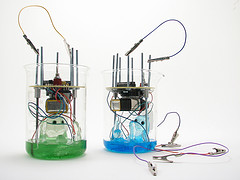This week I am continuing the project-based theme with an emphasis on K-5 grades.
Article 2; topic 3 (PBL)
Technology integration applied to project-based learning in science, by Lih-Juan Chan Lin (2008).
In this week’s article it looks at how technology can be effectively integrated in to project-based learning (PBL) for scientific inquiry. Science and social studies are two of my favorite content areas to teach, so I was automatically drawn to this article because of its science focus. I was also interested in how technology was integrated into the project-based approach since last week I reviewed an article that looked at how project-based learning supports the development of 21st century skills.
The article I read was a study that was held in Taiwan with 5th grade students, who participated in a science camp called SciCamp from October 2004 to April 2005. The project that was observed was called ‘Exploring Our Hometown’ in which groups of four to five students chose an area of their school district and looked at natural, environmental, geographical, social and historical issues. Students began with designing an action plan for gathering information and resources; they also collected water samples, and conducted interviews. Students used computers in a number of ways; they used them for recording test results, editing pictures, researching online, communicating and creating a presentation. The results of the study were formed from interviews, field notes, journals and students’ work and reflected that “students developed basic computer skills” and gained a conceptual understanding of scientific observation and ways to conduct research (p. 59). Other important findings of the study showed that students gained experience with collaborating with students to accomplish a group project by learning to negotiate and problem solve with group members. Lastly the study showed that when students engage in PBL with technology integrated that they gain experience and skills to search for information using the web and how to problem-solve with computers.
This study had students use technology often when gathering information for their presentations. What I was impressed with when reading how the technology that was used, was that it was used in real-world ways. These fifth grade students were given opportunities to work with computer software like Word and Excel, digital cameras and photo editing software that they will use over and over again in the future. I think that it is very important to give students these opportunities because it allows them to practice and gain skills early on so when they get to middle school and high school there won’t be such a shock when they have to research and type up a paper. By designing assignments that allow students to practice using digital tools teachers are able to design relevant learning experiences and meet NETS-T standard #2.
An interesting aspect of the project students were engaged in during the study was that students were able to participate in a larger cyber community. This was made possible by students being involved in water testing for World Water Day. In this assignment students tested water samples of their school district and submitted the testing data to the website. Students also participated in web-based interactions through the website. I think that this could be a very engaging activity for students and also allows them to look at different sets of data. I have also heard about websites in which classrooms can give information about bird migration and other information. I would like to find ways to integrate these kinds of websites into my future classroom. Since students were able to participate in a larger cyber community it meets NETS-S standard #5 because students were able to practice safe, legal, and responsible use of technology.
Another way that the project meets NETS-S standard #5 is that students were responsible for finding and integrating information from online sources as well as give credit to those sources. This is another important skill set for students to gain and one that I think is great to begin in 5th grade. In the study students had to be critical about the sources that they chose to use and to interpret that information to incorporate it into their presentation. Students also used online tools to create presentation with their group members. I can see having students working in groups use Google Docs to create s slideshow presentation since everyone in the group can work on the presentation at the same time using different computers. The research and presentation that students did for their project also meets NETS-S standard #3 since students planned, located and organized information using a variety of sources and media.
Although the article showed great results from the study, the author also brings up some important things to consider. On important thing to consider when thinking about using technology with PBL is the availability of computers. In these types of projects students need to have ample time to work on the computer to complete their research and presentation. Also using technology with elementary students needs scaffolding; projects should build upon computer skills to lessen frustration. Another great idea that was suggested to keep students’ interests high was to have students post their information on their own webpage. I agree with the author that this would be highly engaging for students and also motivating since many people can see their work.

